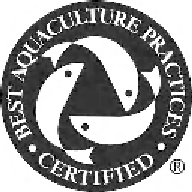Environmental Engineering Reference
In-Depth Information
Figure 5.1
The best aquaculture practices certification mark.
The resulting standards cover the same ground as the codes but define the most
important elements of responsible practices by means of quantitative standards.
They also specify auditing procedures by which adherence to these practices can
be objectively assessed. Along with developing these standards, GAA has registered
a BAP certification mark (Figure 5.1) for use in advertising and on product at the
wholesale and retail levels. Aquaculture facilities that meet the requirements of the
auditing process are deemed to be in compliance with the BAP standards and can
make use of the BAP logo.
The BAP standards (Box 5.1) are grouped under four headings: Community, En-
vironment, Food Safety and Traceability (see www.gaalliance.org/bap.html). The
full, detailed standards, accompanied by guidance notes and auditing forms, are
freely available from Aquaculture Certification Council, Inc., the agency that has
been assigned exclusive use of the BAP standards for certification purposes (see
below). The detailed standards are designed for people who wish to enter the BAP
programme and they are the same documents that are used by independent certi-
fiers that visit aquaculture facilities to make inspections. Currently, there are BAP
standards for shrimp farms, hatcheries and processing plants. The corresponding
documents for feed mills and laboratory verification of food safety in finished prod-
ucts are being finalised. Participating feed mills will be required to demonstrate that
they have adopted adequate procedures for manufacturing feeds free from biologi-
cal and chemical hazards. Feed mills will also be encouraged to provide information
on the fishmeal and fish oil content of their feeds, so that farmers can make increas-
ingly efficient use of these limited natural resources. To meet demand for finfish
standards, the GAA is expanding the BAP programme to include tilapia, salmon,
shark catfish (
Pangasius spp.
) and channel catfish. The new fish standards address
additional issues such as waste from cage sites, fishmeal usage and animal welfare.
The larger, often vertically integrated, aquaculture operators have been financially
and technically most able to modify their practices to meet the BAP standards. To
address the needs of the myriad of small-scale farmers with more limited financial
and technical resources, GAA is developing special provisions so that multiple small
farms can certify in 'clusters'. Cluster certification encourages small enterprises to
form associations with their neighbours and to meet the BAP criteria collectively,









Search WWH ::

Custom Search